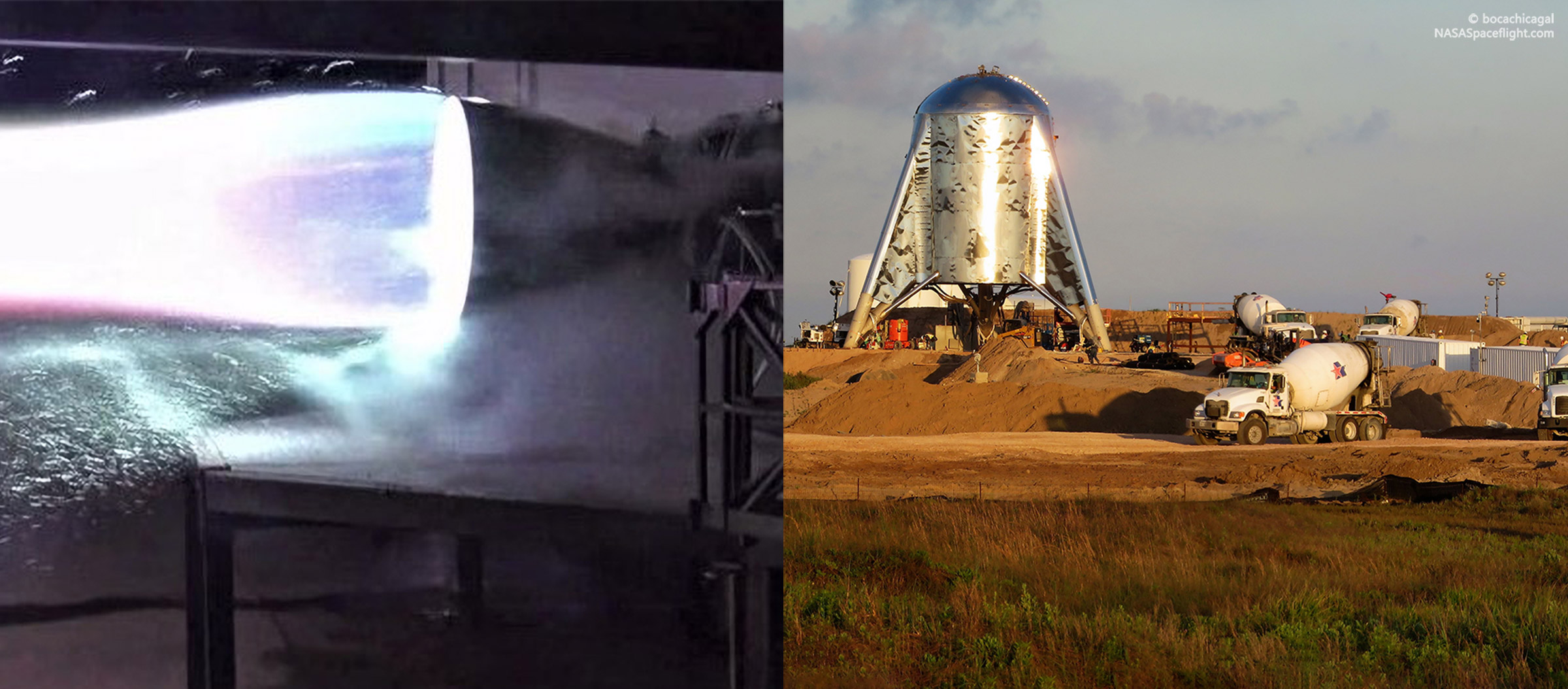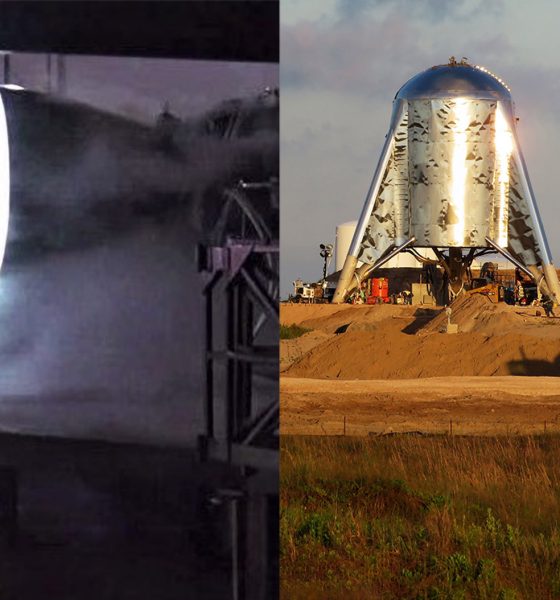

News
SpaceX wants to unleash Starhopper but longer Raptor test fires come first
According to SpaceX CEO Elon Musk, the next round of Starhopper activity will focus on removing the spacecraft prototype’s tethers and performing far more substantial hop tests.
Longer tests demand that SpaceX begins expanding the known performance envelope of its full-scale Raptor engine. Towards that end, longer-duration tests would need to be done at the company’s McGregor, TX development facilities to reduce risk, tests that Musk confirmed are already well underway. A recent Raptor static fire reportedly lasted no less than 40 seconds, more than enough time for a single-engine Starhopper to significantly expand both the maximum altitude and velocity of future hop tests. In support of the upcoming Starhopper test campaign, significant construction work is also ongoing at SpaceX’s Boca Chica test and development facilities.

Unleashing the Hopper
During the months of March and April, SpaceX’s South Texas team effectively completed Starhopper and put the prototype through its first real tests. The process began with tank proof tests in which Starhopper’s tanks were filled with liquid nitrogen – relatively neutral and unreactive – to safely identify and repair any leaks, while also subjecting the vehicle to cryogenic temperatures. The proof testing also put the newly installed ground systems (GSE) and vehicle-pad connection hardware through their paces before moving to Starhopper’s nominal liquid oxygen and liquid methane propellant.
Following at least half a dozen or so wet dress rehearsals (WDRs) that saw Starhopper loaded with LOx and methane, SpaceX technicians analyzed the health of the prototype and soon began live tests with a Raptor engine installed. Designed to produce no less than 2000 kN (450,000 lbf, 205 mT) of thrust at full throttle, Raptor offers more than twice the max thrust of the latest variant of the Merlin 1D engine that powers Falcon 9 and Heavy (941 kN or 212,000 lbf). In other words, a single Raptor should be more than enough to lift Starhopper off the ground 150+ tons of propellant aboard.
After several unsuccessful test attempts, Starhopper completed two static fires (<10s combined) and hopped – tethered – a handful of feet off the ground on April 3rd and 5th, three weeks after Raptor was first installed. Days later, the lone Raptor engine was removed from Starhopper and shipped back to SpaceX’s Hawthorne, CA factory or McGregor, TX testing facilities for post-test analysis and inspection. In short, SpaceX used Starhopper as a sort of ad hoc test stand for the second serial Raptor (SN02) produced, completing two major acceptance tests simultaneously.
A handful of concise tweets published by Musk in the last few days of April implicitly confirmed that the next steps for Starhopper involved untethered flights off its South Texas pad, once again powered by a single Raptor engine. As both the prospective altitudes and flight times rise for future Starhopper tests, so do the risks posed to SpaceX’s adjacent facilities and the prototype itself. To minimize those risks and progress the Raptor program as a whole, SpaceX has been extensively testing the third serial Raptor (SN03) at its McGregor facilities. Instead of a rushed test regime similar to the one that almost completely destroyed Raptor SN01 less than two weeks after testing began, SN03 is participating in a more cautious and systematic series of tests.


Confirmed by Elon Musk, this included significantly increasing the length of Raptor SN03’s latest static fires, culminating in an April 27th test that lasted ~40 seconds. Above all else, long test fires are necessary to demonstrate that Raptor can reliably operate for dozens of seconds at a time, given that any failure leading to a loss of thrust could cause Starhopper – basically a controlled explosive device – to fall out of the sky. The famous Musk/SpaceX ethos of moving fast and breaking things does not preclude a pragmatic attitude towards the destruction of facilities and prototypes that could take months and millions of dollars to rebuild.
The ETA of future hop tests is unclear. For the time being, it appears that SpaceX’s South Texas facilities will be caught up in construction work for at least another week. Whether or not Raptor SN03 is next in line for installation on Starhopper, SpaceX will likely put it through several more long-duration static fires before moving ahead with untethered hop tests. All things considered, the rough Starship prototype is unlikely to restart powered testing for another two or so weeks. Stay tuned!
Check out Teslarati’s Marketplace! We offer Tesla accessories, including for the Tesla Cybertruck and Tesla Model 3.

Elon Musk
Elon Musk and Tesla AI Director share insights after empty driver seat Robotaxi rides
The executives’ unoccupied tests hint at the rapid progress of Tesla’s unsupervised Robotaxi efforts.

Tesla CEO Elon Musk and AI Director Ashok Elluswamy celebrated Christmas Eve by sharing personal experiences with Robotaxi vehicles that had no safety monitor or occupant in the driver’s seat. Musk described the system’s “perfect driving” around Austin, while Elluswamy posted video from the back seat, calling it “an amazing experience.”
The executives’ unoccupied tests hint at the rapid progress of Tesla’s unsupervised Robotaxi efforts.
Elon and Ashok’s firsthand Robotaxi insights
Prior to Musk and the Tesla AI Director’s posts, sightings of unmanned Teslas navigating public roads were widely shared on social media. One such vehicle was spotted in Austin, Texas, which Elon Musk acknowleged by stating that “Testing is underway with no occupants in the car.”
Based on his Christmas Eve post, Musk seemed to have tested an unmanned Tesla himself. “A Tesla with no safety monitor in the car and me sitting in the passenger seat took me all around Austin on Sunday with perfect driving,” Musk wrote in his post.
Elluswamy responded with a 2-minute video showing himself in the rear of an unmanned Tesla. The video featured the vehicle’s empty front seats, as well as its smooth handling through real-world traffic. He captioned his video with the words, “It’s an amazing experience!”
Towards Unsupervised operations
During an xAI Hackathon earlier this month, Elon Musk mentioned that Tesla owed be removing Safety Monitors from its Robotaxis in Austin in just three weeks. “Unsupervised is pretty much solved at this point. So there will be Tesla Robotaxis operating in Austin with no one in them. Not even anyone in the passenger seat in about three weeks,” he said. Musk echoed similar estimates at the 2025 Annual Shareholder Meeting and the Q3 2025 earnings call.
Considering the insights that were posted Musk and Elluswamy, it does appear that Tesla is working hard towards operating its Robotaxis with no safety monitors. This is quite impressive considering that the service was launched just earlier this year.
Elon Musk
Starlink passes 9 million active customers just weeks after hitting 8 million
The milestone highlights the accelerating growth of Starlink, which has now been adding over 20,000 new users per day.

SpaceX’s Starlink satellite internet service has continued its rapid global expansion, surpassing 9 million active customers just weeks after crossing the 8 million mark.
The milestone highlights the accelerating growth of Starlink, which has now been adding over 20,000 new users per day.
9 million customers
In a post on X, SpaceX stated that Starlink now serves over 9 million active users across 155 countries, territories, and markets. The company reached 8 million customers in early November, meaning it added roughly 1 million subscribers in under seven weeks, or about 21,275 new users on average per day.
“Starlink is connecting more than 9M active customers with high-speed internet across 155 countries, territories, and many other markets,” Starlink wrote in a post on its official X account. SpaceX President Gwynne Shotwell also celebrated the milestone on X. “A huge thank you to all of our customers and congrats to the Starlink team for such an incredible product,” she wrote.
That growth rate reflects both rising demand for broadband in underserved regions and Starlink’s expanding satellite constellation, which now includes more than 9,000 low-Earth-orbit satellites designed to deliver high-speed, low-latency internet worldwide.
Starlink’s momentum
Starlink’s momentum has been building up. SpaceX reported 4.6 million Starlink customers in December 2024, followed by 7 million by August 2025, and 8 million customers in November. Independent data also suggests Starlink usage is rising sharply, with Cloudflare reporting that global web traffic from Starlink users more than doubled in 2025, as noted in an Insider report.
Starlink’s momentum is increasingly tied to SpaceX’s broader financial outlook. Elon Musk has said the satellite network is “by far” the company’s largest revenue driver, and reports suggest SpaceX may be positioning itself for an initial public offering as soon as next year, with valuations estimated as high as $1.5 trillion. Musk has also suggested in the past that Starlink could have its own IPO in the future.
News
NVIDIA Director of Robotics: Tesla FSD v14 is the first AI to pass the “Physical Turing Test”
After testing FSD v14, Fan stated that his experience with FSD felt magical at first, but it soon started to feel like a routine.

NVIDIA Director of Robotics Jim Fan has praised Tesla’s Full Self-Driving (Supervised) v14 as the first AI to pass what he described as a “Physical Turing Test.”
After testing FSD v14, Fan stated that his experience with FSD felt magical at first, but it soon started to feel like a routine. And just like smartphones today, removing it now would “actively hurt.”
Jim Fan’s hands-on FSD v14 impressions
Fan, a leading researcher in embodied AI who is currently solving Physical AI at NVIDIA and spearheading the company’s Project GR00T initiative, noted that he actually was late to the Tesla game. He was, however, one of the first to try out FSD v14.
“I was very late to own a Tesla but among the earliest to try out FSD v14. It’s perhaps the first time I experience an AI that passes the Physical Turing Test: after a long day at work, you press a button, lay back, and couldn’t tell if a neural net or a human drove you home,” Fan wrote in a post on X.
Fan added: “Despite knowing exactly how robot learning works, I still find it magical watching the steering wheel turn by itself. First it feels surreal, next it becomes routine. Then, like the smartphone, taking it away actively hurts. This is how humanity gets rewired and glued to god-like technologies.”
The Physical Turing Test
The original Turing Test was conceived by Alan Turing in 1950, and it was aimed at determining if a machine could exhibit behavior that is equivalent to or indistinguishable from a human. By focusing on text-based conversations, the original Turing Test set a high bar for natural language processing and machine learning.
This test has been passed by today’s large language models. However, the capability to converse in a humanlike manner is a completely different challenge from performing real-world problem-solving or physical interactions. Thus, Fan introduced the Physical Turing Test, which challenges AI systems to demonstrate intelligence through physical actions.
Based on Fan’s comments, Tesla has demonstrated these intelligent physical actions with FSD v14. Elon Musk agreed with the NVIDIA executive, stating in a post on X that with FSD v14, “you can sense the sentience maturing.” Musk also praised Tesla AI, calling it the best “real-world AI” today.








